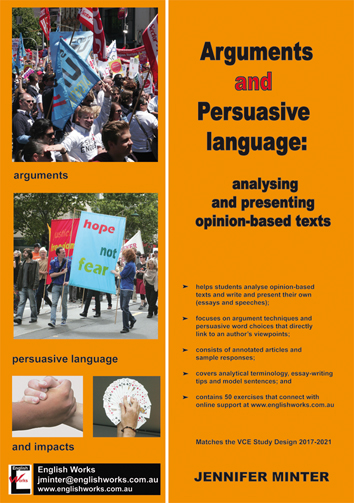Tip: Note the “self-check” or the breakdown in the argument. This ensures that you have control of your paragraph and are able to move from the “broad” focus to a “specific” focus. It also makes it easier to make comparative comments.
By way of context, Ms Scott refers to her recent visit to the Turkey meatworks. (personal/professional experience)
Ms Scott’s point of view:
Ms Scott criticises the live animal trade exporters; (decries /condemns) the trade because it barbaric …
Ms Scott recommends/ endorses a ban on live animal exports.
(The punning title, “skinning the cat” reflects the author’s view that the trade is exploitative and barbaric.)
Argument base:
Ms Scott bases her argument on different types of evidence: (an academic expert: Ms Julie Smith); she corroborates this evidence with her own.
Audience segments:
The author seeks to convince/ challenge those who condone the animal trade (overlook, turn a blind eye to)
- Aimed at those who appear complacent or indifferent towards the fate of the animals, Ms Scott …
- Targeting unsuspecting or naïve members of the public, Ms Scott …
- To jolt many policy officers and farmers out of a sense of complacency (comfortable naivety; indifference) …
Narrow-specific focus: See Quotes: words with an analytical story: p. 38

Emotive language: visual imagery; a narrative recount of the barbaric treatment. (She gives an image of animals at one meatworks that were “shackled and hoisted into the air”. This enables her readers to visuals the horrible treatment and she hopes that they will be suitably shocked.. revulsion.)
The visual image of the animals “being shackled” and “wallowing in their excrement” compels the audience to voice their outrage at the barbaric practices.
The author gives an image of animals that do survive, which are “thrown into the car boots and other modes of transport”.. .
This refers to the brutality of the animals that are shipped to countries with “no animal welfare laws”
Quote 1: The figurative reference to “skinning the cat” is designed to shock / alarm policy officials who are unaware of the fate of the animals.
Specifically, Ms Scott uses the figurative reference of the “skinned” cat to draw attention to a trade which is exploiting the animals for sheer profit. She thereby seeks to shame farmers as well as government policy officers who fail to implement more humane solutions.
Specifically, Ms Scott uses the figurative reference
of the “skinned” cat to draw attention to a trade which is exploiting the
animals for sheer profit.
The use of a familiar pet such as a cat evokes connotations of love and care. This sentiment is juxtaposed with one of shock and brutality as the “skinned” cat is equated to the sheep wallowing in their “excrement”. This highlights the exploitative attitude towards animals that is at the heart of the live-animal trade.
Ms Scott thereby seeks to shame farmers and as well as government policy officers who fail to implement more humane solutions.
Quote 2: As Ms Julie Smith reminds the audience, it is a “race to the bottom”, in countries like Somalia and Sudan, which have no welfare regulations. Appealing to a sense of decency, the author hopes that even the most sceptical members of the community will support the ban.
Quote 3: Likewise, Ms Scott’s also cites her own personal visit to the “meatworks in Turkey” as testimony to the brutality. The fact that she saw “sheep and cattle being shackled and hoisted by a rear leg into the air” and that sheep were “lying in their own excrement” seeks to soften the emotions of those who try to shut out the suffering.
Quote 2: As Ms Julie Smith reminds the audience, it is a “race to the bottom”, in countries like Somalia and Sudan, which have no welfare regulations. Appealing to a sense of decency, the author hopes that even the most sceptical members of the community will support the ban.
Quote 3: Likewise, Ms Scott’s also cites her own personal visit to the “meatworks in Turkey” as testimony to the brutality. The fact that she saw ‘sheep and cattle being shackled and hoisted by a rear leg into the air” and that sheep were “lying in their own excrement” seeks to soften the emotions of those who try to shut out the suffering.
Ms Scott compares the Australian and New Zealand models; this comparison substantiates her view that there are more humane solutions. This comparison also serves to sideline those officials who suggest that there are no economic solutions.
Call to action:
Ms Scott prevails upon the government to enforce laws that would protect animals.
Prevailing upon the government to enforce laws that would protect animals, Ms Scott hopes that the government will not continue to condone the “intolerable” “race to the bottom”.
Exercises Return to Orange VCE Membership Program